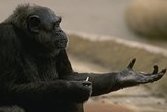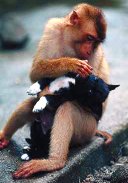Most primates
spend their lives in complex, tightly woven societies and need to frequently communicate with
each other. They communicate with smells, sounds, visual messages, and
touching. Non-human primates emphasize the use of
body language.
Human communication is far more focused on the use of oral sounds. Our speech is radically different from the hoots, howls, whistles,
barks, slaps on the
ground, and other sounds used by non-human primates to communicate. Our
languages are complex symbolic systems. That is to say, our words are
combinations of sounds to which we arbitrarily assign a specific meaning. Like all symbols, the meaning of words cannot be discerned by listening to the
sounds. They must be explained. This is very different from a
universally understood cry out from pain or fear.
Human communication using a system of symbols for oral and written language
Human language also has the characteristics of being both open and discrete. Openness refers to the ability to communicate about totally new things and ideas. In contrast, other primates almost exclusively communicate their present emotional mood and intentions. They are focused on the here and now. Discreteness refers to spoken words being individually distinct from others in the same phrase or sentence--they don't blend together. The oral sounds of some apes and monkeys are somewhat discrete at times as well. Unlike us, however, their communication does not involve displacement. That is, they apparently do not "talk" about things and events that are not here and now. People discuss such things as what the world was like two centuries ago. There is no evidence that non-human primates do this.
Can non-human primates learn and use human languages? Do they have the mental ability to comprehend a symbolic communication system and to use it creatively? Research with chimpanzees, bonobos, and gorillas to answer these questions has been ongoing since the 1960's. It is now clear that at least the African apes can learn and use a simplified version of the American Sign Language for the Deaf (ASL). However, it is not universally agreed that they can do so in an innovative way like adult humans. One of the stars in this research has been a male bonobo named Kanzi. Listen to the video and audio slide show linked below and make up your own mind about how well he uses language.
The (Monkey) Business of Recognizing Words--Baboon ability to recognize
written English words. This link takes you to an external website.
(length = 3 mins, 57 secs.)How Animals Learn Language--TIME magazine science writer Jeffrey Kluger
visits the Great Ape Trust to meet Kanzi.
This link takes you to an external website. (length = 3 mins, 14 secs.)Kanzi the Bonobo--primatologist Sue Savage-Rumbaugh talks about Kanzi's
ability to learn and use human language
This link takes you to a 5 part audio slide show at an external website.
(total length of the 5 parts = 6 mins, 15 secs.)
Non-Human Primate Communication
 |
|
| Chimpanzee begging gesture and facial expression |
Odors, vocalizations, gestures, and facial expressions are used by non-human primates to inform others of their psychological state and present concerns, which is an important clue to what they are likely to do next. In the picture on the left, the outstretched hand and pleading facial expression directed toward another group member are obvious indications of this chimpanzee's appeal for sharing. It also probably reflects and reinforces his or her lower position on the dominance hierarchy within the community.
Primatologists have observed that some communication patterns are commonly used by many primate species. These are discussed below.
Prosimians
have excellent olfactory
![]() sensing abilities. It is not surprising,
therefore, that they usually use body odors to communicate. Adult
male ring-tailed lemurs regularly mark their woodland territories with chemicals produced
by scent glands in their wrists. This is similar to dogs, wolves, and
cats marking their territories with urine. In both cases, the scent is
recognized as a personal signature. Tamarins and marmosets also use
scented urine to mark the gum trees that are important food sources in their territories. In all of
these species, scent marking is a way of claiming territory and warning off
intruders.
sensing abilities. It is not surprising,
therefore, that they usually use body odors to communicate. Adult
male ring-tailed lemurs regularly mark their woodland territories with chemicals produced
by scent glands in their wrists. This is similar to dogs, wolves, and
cats marking their territories with urine. In both cases, the scent is
recognized as a personal signature. Tamarins and marmosets also use
scented urine to mark the gum trees that are important food sources in their territories. In all of
these species, scent marking is a way of claiming territory and warning off
intruders.
Using scent to communicate is not unique to prosimians. All primates, including humans, do so to some extent. People do not mark territory with scent or battle each other with it, but we do produce odors that may attract or repulse others. Think about the effect you might have on your friends if you did not bathe or shower for several days. Humans have learned to cover up body odors with perfumes and other products. Our cultures tell us that some of these odors are attractive. However, our bodies also produce pheromones, which are chemicals that give off powerful, often subliminal, odors that have effects on the physiology and behavior of others in our species whether they are aware of it or not. Very importantly, there are different male and female pheromones that play a part in sexual attraction and ovulation regulation. It is likely that all primates produce such pheromones.
|
|
 |
 |
||
|
Agonistic
displays by a |
|||
Most
primate species, including humans, use threatening gestures, stares, and poses
to intimidate others. Primatologists refer to this particular use of body language
as agonistic displays
![]() . Among non-human primates, they are usually
sufficient to prevent physical fighting. In fact, physically violent
encounters are rare among them. The dominant male in a monkey or ape
community can usually prevent major conflicts and keep order by the use of
often subtle agonistic displays. For instance, male baboons flash their
eyelids when they are angry and want to intimidate others. If this isn't sufficient
in its effect, they open their mouths widely in a
manner that looks like human yawning. This is usually the last warning
before attacking. Since the marmosets and tamarins
cannot significantly change their facial expressions, their agonistic displays
are different. Adult males chirp repeatedly and turn around to show
their genitals from behind. This is the ultimate threat for them.
. Among non-human primates, they are usually
sufficient to prevent physical fighting. In fact, physically violent
encounters are rare among them. The dominant male in a monkey or ape
community can usually prevent major conflicts and keep order by the use of
often subtle agonistic displays. For instance, male baboons flash their
eyelids when they are angry and want to intimidate others. If this isn't sufficient
in its effect, they open their mouths widely in a
manner that looks like human yawning. This is usually the last warning
before attacking. Since the marmosets and tamarins
cannot significantly change their facial expressions, their agonistic displays
are different. Adult males chirp repeatedly and turn around to show
their genitals from behind. This is the ultimate threat for them.
Most
primate species communicate affection and reduce group tension by what are
known as affiliative behaviors. These include calmly sitting
close to each other, touching, and mutually
grooming. The latter is referred to as allogrooming
![]() in contrast to self
or autogrooming
in contrast to self
or autogrooming
![]() . Allogrooming is a powerful tool for
communication. It is used by both monkeys and apes to reinforce
male-female mate bonds as well as same sex friendship bonds. Chimpanzees often have
ecstatic bouts of allogrooming that go on for hours when an old acquaintance
rejoins the community. They also do it to calm emotions following wild,
aggressive outbursts by angry adult males. Most members of the community
also seem to very much enjoy grooming infants and may compete for the opportunity.
. Allogrooming is a powerful tool for
communication. It is used by both monkeys and apes to reinforce
male-female mate bonds as well as same sex friendship bonds. Chimpanzees often have
ecstatic bouts of allogrooming that go on for hours when an old acquaintance
rejoins the community. They also do it to calm emotions following wild,
aggressive outbursts by angry adult males. Most members of the community
also seem to very much enjoy grooming infants and may compete for the opportunity.
Allogrooming usually has measureable physiological effects on both the individual being groomed and the one doing the grooming. It can cause the release of endorphins into the blood. These are hormones that have opiate-like effects on the body--they reduce the sensation of pain and cause a pleasant emotional state.
Allogrooming chimpanzees, douc langurs, and crab-eater macaques
It is clear that allogrooming results in both social and psychological benefits for non-human primates. It often serves much the same purposes for humans, whether it be in the private setting of a family at home, where a parent might brush a child's hair, or in a public barbershop or beauty salon. The experience of having someone run their fingers through your hair and massage your head in the process is usually physically pleasurable, and it generally provides a period of time removed from work or school concerns when relaxed, casual conversation occurs.
Among some species of primates, including humans, the urge to allogroom is so strong as to result in grooming animals of other species. Among non-human primates, inter-species allogrooming sometimes occurs when they are in captivity and deprived of the opportunity to groom their own kind. They are even known to groom people. However, it does not seem to be a pattern of wild non-human primates.
 |
 |
|
|
A macaque and a
human enjoy |
Petting a willing, appreciative dog has been shown in experiments to reduce the blood pressure of humans. This surprising psychological effect potentially has medical implications.
Clever Monkeys--monkey intelligence and communication (BBC Natural World)
This link takes you to an external website. Watch all 6 parts. To return here,you
must click the "back" button on your browser program.
(total length = 48 mins. 58 secs.)

